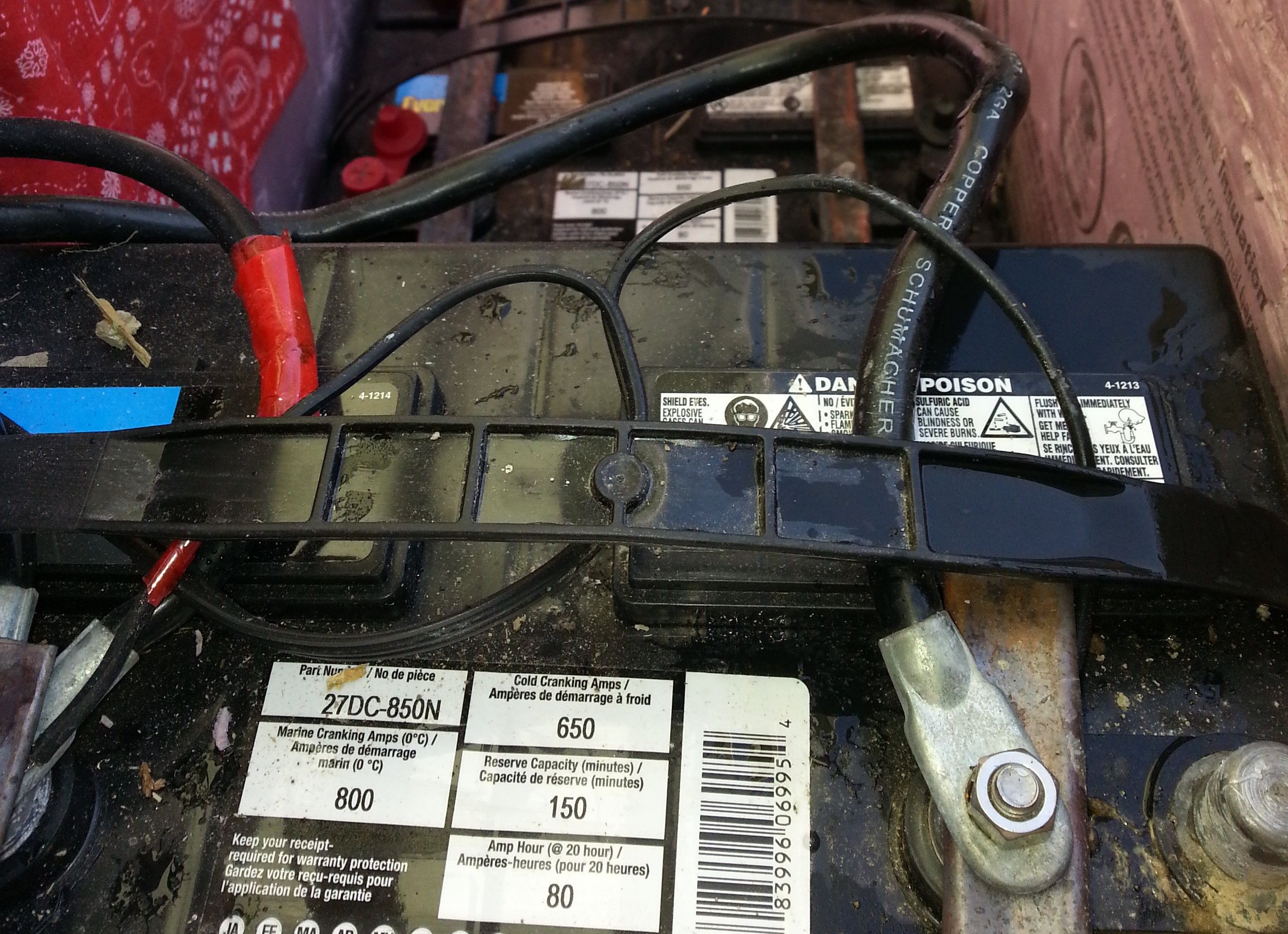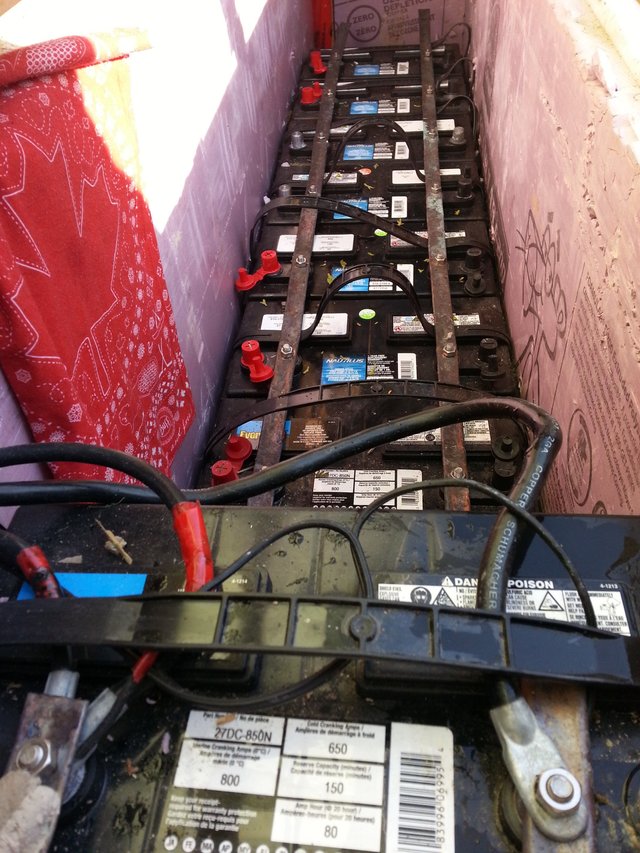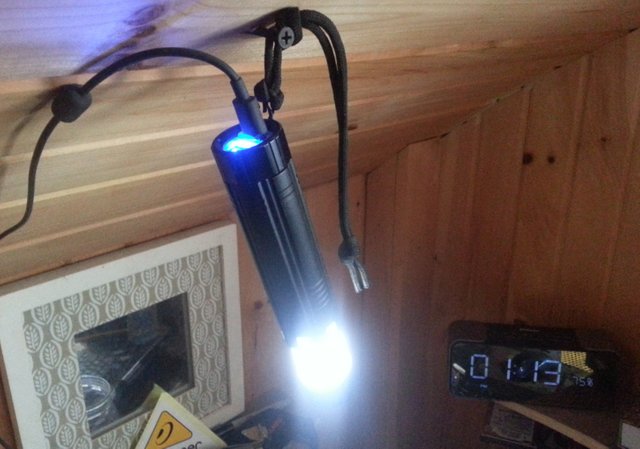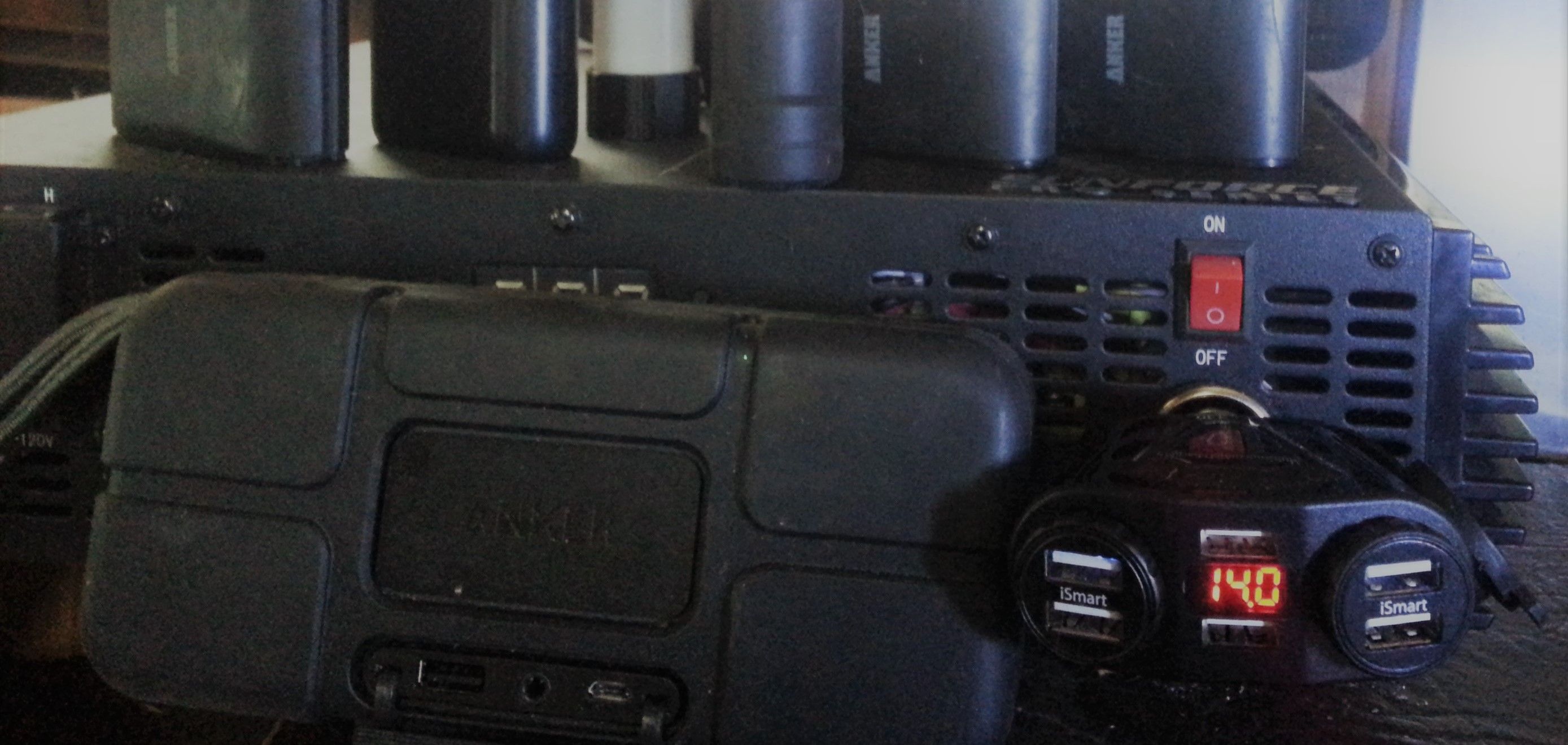Off-grid: How to Calculate the Battery Bank Size for Your Off-grid System or Emergency Power Needs
Deep Cycle Lead Acid Batteries are the most commonly used batteries for Off-grid Solar, Backup Systems, Boats, and RVs. There are many different types of Lead Acid batteries. Each type has a unique construction, method of charging, and price point. Flooded is the traditional engine starting lead acid battery, there's also Sealed, VRLA, AGM, and GEL. Deep Cycle lead acid batteries can discharge up to 80% of their rated amp hours without being damaged. Common car starting lead acid batteries can only discharge 30% of their rated amp hours without risk of damage to the batteries. Lithium Ion batteries in comparison can discharge 100%. Lithium ion batteries are great for a home battery bank, but very pricey right now, unless you build one yourself.
My cabin came with four 12 Volt deep-cycle lead-acid flooded 80 Amp hour capacity batteries, so my choice for the Voltage, Type, and Capacity of each battery was easy. Flooded lead acid batteries are also readily available to be purchased at your local hardware or car repair store. I've since added six more 80 Ah batteries, for a total of ten - making it a 800 Amp hour battery bank. It is important that each of the batteries in the battery bank are the same voltage, type, and capacity, or there will be trouble.
Deep cycle lead acid batteries can discharge up to 80% when running 12 volt items, but a heavy load on an Inverter from larger household standard appliances will cause the Inverter to turn off at about 50% of battery capacity. This brings the cabin battery bank's usable 12 Volt invertable electricity storage to about 400 Amp hours.
When the Sun or the Electrical Power Grid goes down, a battery bank can keep the electricity flowing. A twenty-four hour capacity battery bank would be a good size goal to start with. With a solar power setup, the sun will shine or at least overcast the next day to charge up the battery bank. For extended cloudy days or a grid power outage, a backup generator and charger works great for topping off the batteries during the day - so you can use electricity from the batteries at night.
To Know What Size Battery Bank You Need, First Calculate Your Daily Minimum Electrical Power Needs.
For many, refrigeration would be at the top of the list. One of the few appliances that need to be plugged in day and night. In a power grid down situation, if you have a natural gas furnace, the furnace and blower can be run on backup power. Well water pumps could be ran too, but I would wait until day or when the generator is running to fill up containers with water.
Chargeable devices like tools, phones, laptops, USB battery banks, Bluetooth speakers, flashlights, clocks, AM/FM radios, 2-way radios, GPS devices, Geiger counters, drones, and many more chargeable devices can be very useful for cutting back on night time non-essential electricity needs.
In the picture below you can see my USB chargeable flashlight lamp and Bluetooth speaker clock. If the power ever unexpectedly cuts out, they just keep running. If battery bank power is low at night, I will unplug the charging cords and run them off their own batteries.
The picture below is an example of how to collect and charge USB Battery Banks #LikeABoss.
Watts = Voltage X Amps
Amps = Watts / Voltage
Amp Hours per Day Usage: Calculation Example
We will use a Refrigerator and a Gas Heat Furnace Blower from the Efficiency Smart Guide page for this example. There are many other common household appliances on the Efficiency Smart page:
https://www.efficiencysmart.org/media/default/docs/programs/meter-loan/efficiency-smart-usage-chart.pdf
Refrigerator, 19.0 - 21.4 cu. ft., 2001-2008:
533 Kilowatt hours per year / 365 days per year = 1.460 Kilowatt hours per day
1.460 Kilowatt hours per day / 1000 = 1460 Watt hours per day
1460 Watt hours per day / 12 Volts = 121.67 Amp Hours per day
Gas Heat Furnace Blower:
498 Kilowatt hours per year / 365 days per year = 1.364 Kilowatt hours per day
1.364 Kilowatt hours per day / 1000 = 1364 Watt hours per day
1364 Watt hours per day / 12 Volts = 113.67 Amp Hours per day
121.67 Amp Hours per day for Fridge
113.67 Amp Hours per day for Furnace Blower
= 235.34 Amp Hours total required per day
240 Amp Hours from a battery bank could work well for these requirements, but remember that when using an inverter with the battery bank you will only be able to withdraw about 50% of the capacity - so we double the size of the Battery Bank to 480 Amp Hours.
Have a great day!
You may find some of my previous posts useful:
https://steemit.com/homesteadersonline/@jackdub/back-acres-how-to-pull-start-a-small-engine
https://steemit.com/homesteading/@jackdub/my-solar-powered-cabin-setup





Hi @jackdub, going a bit 'left-field' here but those camping fridges that run on gas (don't ask me how that works,..... magic probably lol), if you had a bio-gas generator or even making wood-gas in a basic set-up could possibly power those pesky energy hungry fridges?? More labour and vegetative resource intense though I guess.
You can do a simple conversion on natural gas or propane generators to have them run off of biogas. I remember reading about a pig farmer that would send all the pig droppings to the basement of the pig barn where he had it setup to collect the biogas from it. The biogas ran a generator that powered the whole pig farm and there was enough extra to sell to the grid. It doesn't take much biomaterial or pressure to run a cooking or light burner, but for a generator you would need a lot of biomaterial or just the right kind. Thanks @eggmeister :D
Hi @jackdub, yeah it would be more efficient overall to generate electric for everything rather than splitting the off a portion of the gas produced to power a gas fridge.
Thanks for your reply bud :)
EggMeister
Awesome write up man! Sooo timely too! I was thinking of investing some tax return into solar to get a small setup going just to begin the long journey. We’re on-grid, but would like to wean ourselves off it as much as we can!
Nice, it's good to have a cushion. I have a smaller system down at my camper, just 200 watts of solar panels, but i get good use out of it charging 20v tool batteries and usb battery packs. It takes a little pressure off the main system on the cloudy days. Thanks :)
POWER AUDIT is one thing people shy away from for some reason and its essential and easy to consider / do...
I use Sealed Lead acid batteries (around 500 cycles(or non-maintenance ones as i like to call them because you cannot top them up))... I wouldnt let mine go below 50% charge as the life will be reduced.... as a price comparison i wouldnt get the Lithium Ion ones just yet (too damn expensive) in UK.
i get on average 4-5 years out of a complete bank...
Folk have also got to think about how they are going to charge them too...
Good post.
With some of the elaborate formulas out there, I can see why people might shy away from the audit. But if they want to be realistic with their goals, it is very necessary. While gasoline is still readily available, I found the gas generator and and battery charger combo to be a great way to bridge the gap until the full solar/battery setup is complete. When I eventually setup the battery system for the yet-to-be-built house, I'm goung to look into building my own 'tesla' home lithium ion battery. You build it from individual lithium ion battery cells that you buy in bulk. It's supposed to be less than half the cost so I'll crunch some numbers when the time comes. Thanks @preppervetuk :)
Congratulations! @jackdub, You are now an Official Featured Blogger on Sotall.org. This post has been added to our growing directory of Steemit post for the Homesteading/Survival communities. You can claim your badge along with the code to add to your posts to let the world know you have chosen to help others Survive, Thrive and be Prepared! Click here to get the code
Why use an electric fridge?
Propane or old school hole in the ground. Could also use an ice box with blocks of ice too.
In the spring I'll be putting a root cellar next to my cabin to put the converted to fridge freezer in, the solar panel power usage will be limited and non existant when vented in the winter. While I have solar panel power, electric refrigeration is the cheapest and easiest. If I had no solar panel power I would be using one of your methods. Stacking ice in winter for the summer is a lot of work! :)
We have been thinking of using a dead freezer for a cellar. Solar is pointless in the winters up here. Not enough light. I would have to cut a lot of trees to get the light. The sun stays low on the horizon.
In the summer it would be amazing!
I think harvesting ice wouldn’t be that bad, lot of work but you have to stay fit for when TSHTF. LOL
Ultimately i could see eating fresh veggies in the summer and root cellar veggies with sprouts and micro greens in the winter. Fresh eggs year round. There's not much else I need to refrigerate.
Congratulations! This post has been upvoted from the communal account, @minnowsupport, by jackdub from the Minnow Support Project. It's a witness project run by aggroed, ausbitbank, teamsteem, theprophet0, someguy123, neoxian, followbtcnews, and netuoso. The goal is to help Steemit grow by supporting Minnows. Please find us at the Peace, Abundance, and Liberty Network (PALnet) Discord Channel. It's a completely public and open space to all members of the Steemit community who voluntarily choose to be there.
If you would like to delegate to the Minnow Support Project you can do so by clicking on the following links: 50SP, 100SP, 250SP, 500SP, 1000SP, 5000SP.
Be sure to leave at least 50SP undelegated on your account.
You got a 100.00% upvote from @greengrowth thanks to @jackdub! You too can use @GreenGrowth by sending your post URL in the memo field to the bot. Minimum bid is 0.01.
If you feel this post is spammy or not worthy of @Greengrowth you can contact a moderator in our Discord Channel https://discord.gg/6DhnVTQ.
great information and really important for people wishing to go off grid. We've been off grid for the last 8 years, always had solar in our bus and now also in our truck. Having a really good solar controller is a must.
The MPPTs charge controllers are almost needed with the large battery banks. I'll be doing a post soon about the different types of solar panels and charge controllers. Thanks @trucklife-family :)
@alaskatactical you should check this guy out. He has a lot of the stuff we have been looking into.
👍👍
There's some good advice in that article. It's very important to know your use before starting a system, not just the constant, daily use but include sudden, peak loads for both emergencies and if you want to use a high draw device such as a drill
For sure. For power tools we use trickle charged 20v batteries to help lighten the load on the system. Lead acid batteries do well at peak loads. It's also best if you are able to do those tasks and full sun. Inverter wattage would also be important for handling the load - I'll be discussing inverter and other pars of the system in upcoming posts :)
Thats good info.At the moment we're running everyhing at 240V through a cheap ebay inverter
Do you need to do anything to convert the 20V from the batteries to that used by the powertools?
Standard cordless power tools that have a compatible 20v battery pack so i can use the 20v battery packs with any of the tools, they use straight 20v from the battery pack i presume .. have a drill, circular saw, lawn trimmer, bike and car tire filler compressor, multiple flash/flood lights, and a chainsaw that all use these 20v battery packs that i trickle charge off the panels when the sun's out.
Thats the best option ive come up with too, charge the tools batteries via the solar. At the moment im charging them via their 240V charger via the inverter, but am planning to put in a dedicated 18V DC circuit so I can charge directly from the solar batteries.
Oh, yeah for the charging the 20v batteries i still go through the inverter too. I havent approached charging them from 12v to 20v yet.
Now that i think of it, it wouldnt take much more amperage than a laptop, so one of those 12v-20v Converters should work, but i haven't tried it out yet with the 20v batteries... https://steemit.com/off-grid/@jackdub/tech-talk-get-more-power-out-of-your-off-grid-system-with-single-voltage-conversion